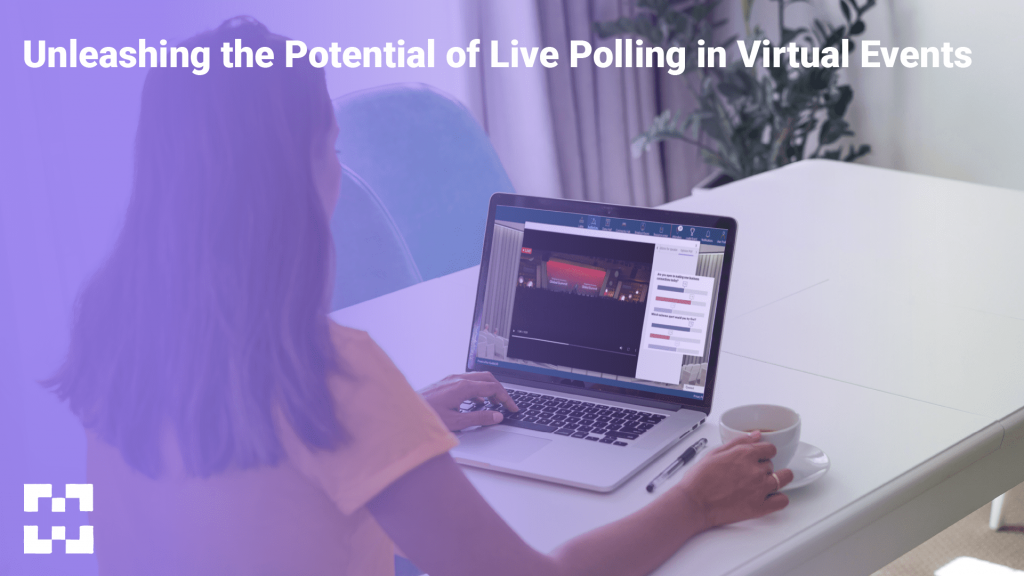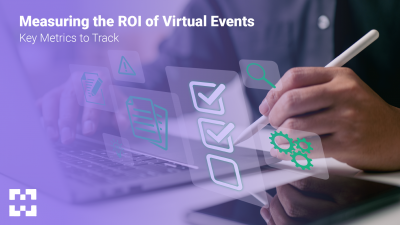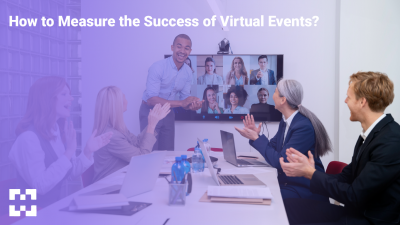
Discover how to maximize the potential of live polling in virtual events. From enhancing participant engagement and real-time data collection to creating interactive experiences and driving audience retention, this blog explores practical tips for using live polling to make your virtual events more engaging.
Virtual events have become the new norm in today’s digitally connected world, allowing people from around the globe to come together and participate in conferences, webinars, and other interactive gatherings.
While the convenience of virtual events is undeniable, event organizers often face the challenge of keeping attendees engaged and maintaining their interest throughout the proceedings. This is where live polling comes into play, revolutionizing how virtual events are conducted.
By leveraging live polling, organizers can actively involve participants, create an interactive atmosphere, and gather valuable real-time insights. In this blog post, we will explore the benefits of using live polling during virtual events and provide you with practical tips on how to maximize its potential.
Benefits of Using Live Polling During Virtual Events
1. Enhancing Participant Engagement
One of the primary advantages of incorporating live polling into virtual events is its ability to enhance participant engagement. Traditional virtual events often lack the dynamic nature of in-person gatherings, making it challenging to maintain audience attention. However, by integrating live polling tools, organizers can bridge this gap and create a sense of active participation.
Live polls can be used to pose questions, gather opinions, or even conduct quizzes related to the event’s topic. This prompts attendees to actively engage with the content and express their thoughts, transforming passive observers into active contributors. The instant feedback and visual representation of results that live polling offers also help foster a sense of community and shared experience among participants.
To optimize engagement, it’s important to consider the timing and frequency of live polls. Spread them strategically throughout the event to break up the monotony and keep attendees on their toes. Additionally, keep the polls concise and straightforward to encourage maximum participation.
2. Real-Time Data Collection and Analysis
Live polling during virtual events allows organizers to collect valuable data and insights in real-time. The instantaneous nature of live polling provides an accurate snapshot of attendees’ thoughts and preferences, offering a unique opportunity to shape the event on the fly and tailor content to suit participants’ interests.
By posing targeted questions, organizers can gauge attendee expectations, gather feedback on specific topics, or conduct surveys to better understand their demographics. This real-time data collection eliminates the need for post-event surveys, often plagued by low response rates and recall bias. Organizers can access immediate insights and adjust the event’s direction or content accordingly.
To make the most of live polling data, it is crucial to analyze and interpret it effectively. Identify trends and patterns within the responses to identify common concerns, interests, or preferences. These insights can inform decision-making for future events, speaker selection, and content creation, ultimately improving the attendee experience.
3. Creating Interactive and Collaborative Experiences
Live polling brings a collaborative element to virtual events, fostering interaction between organizers, speakers, and attendees. By involving participants in the decision-making process, organizers create an inclusive environment that encourages active participation and collaboration.
Incorporate live polls during panel discussions or Q&A sessions, allowing attendees to ask questions or vote on topics they want addressed. This gives participants a sense of control and ensures that the event is tailored to their needs and interests. The interactive nature of live polling can also facilitate networking opportunities as attendees discover common interests or engage in discussions based on poll results.
To maximize collaboration, choose a live polling platform with features like anonymous voting, real-time word clouds, or interactive charts to display results. These visual elements add excitement and make the event more engaging for attendees.
4. Promoting Audience Interaction and Connection
One of the biggest challenges of virtual events is creating a sense of connection and community among attendees. Fortunately, live polling can be crucial in promoting audience interaction and fostering meaningful connections.
Live polls can be used to encourage participants to share their experiences, opinions, or even personal anecdotes related to the event’s topic. By doing so, attendees feel heard and valued, creating a sense of belonging and camaraderie. Additionally, live polling can facilitate networking opportunities by allowing participants to discover shared interests and engage in conversations based on poll results.
To maximize audience interaction, consider incorporating live Q&A sessions alongside polls. Attendees can ask questions during a presentation or panel discussion, and the most popular questions can be highlighted through live polling. This approach encourages engagement and ensures that the event addresses the topics that are most relevant to the audience.
Moreover, interactive features such as chat functions or virtual breakout rooms can complement live polling, providing additional spaces for participants to engage in discussions or collaborate on specific topics. These interactive elements enhance the attendee experience and create a sense of community, even in a virtual setting.
5. Driving Audience Retention and Attention
Keeping attendees engaged and focused throughout a virtual event can be challenging, especially with numerous distractions at their fingertips. However, live polling can be a powerful tool to drive audience retention and maintain their attention throughout the event.
By incorporating timely and thought-provoking polls, organizers can create moments of anticipation and excitement, breaking the monotony of presentations and keeping attendees actively engaged. For instance, using live polls to quiz participants on key points covered during a session can help reinforce learning and ensure the audience retains the information presented.
Additionally, live polling can be used strategically to gauge attendees’ interest levels and adapt the event accordingly. If a particular topic receives a lower response rate or shows disinterest, organizers can make adjustments on the spot, such as shifting to a different speaker or changing the presentation format. This flexibility helps maintain audience attention and ensures the event remains relevant and valuable to participants.
To further enhance audience retention, consider incorporating gamification elements into live polling. For example, award points or badges to participants actively participating in polls or providing correct answers. This gamified approach incentivizes engagement and creates a sense of friendly competition among attendees.
Furthermore, live polling can be leveraged to provide real-time summaries or key takeaways from previous sessions, allowing latecomers or those who may have missed parts of the event to catch up quickly. This ensures that all attendees stay informed and connected throughout the virtual event.
In conclusion, live polling is powerful for driving audience retention and attention during virtual events. By utilizing interactive and engaging polling techniques, organizers can captivate attendees, maintain their focus, and deliver an impactful and memorable experience.
Tools for using Live Polling
By incorporating live polling, event organizers can actively involve attendees, gather real-time insights, and foster a sense of community. To harness the full potential of live polling, organizers need reliable and user-friendly tools that facilitate seamless integration and provide impactful features. In this blog post, we will explore some of the top tools used for live polling in virtual events, highlighting their key features, benefits, and considerations. By leveraging these tools, event organizers can captivate audiences and transform virtual events into engaging and collaborative experiences.
1–Mentimeter: Mentimeter is a versatile live polling tool that offers a wide range of interactive features. With Mentimeter, organizers can create real-time polls, quizzes, word clouds, and more, allowing attendees to actively participate and contribute. The platform provides visually appealing presentations and customizable themes, enhancing the overall event aesthetics. Additionally, Mentimeter offers analytics and data visualization tools, enabling organizers to analyze poll results and gain valuable insights. The user-friendly interface and mobile compatibility make Mentimeter an excellent choice for engaging attendees in virtual events.
2-Slido: This is a popular live polling and audience interaction platform trusted by many event organizers. With Slido, organizers can create live polls, Q&A sessions, quizzes, and surveys to encourage attendee participation. Slido offers seamless integration with virtual event platforms, making it easy to embed polls into presentations or Virtual Conference Platforms. The tool provides real-time moderation features, allowing organizers to curate and manage audience questions effectively. Slido also offers robust analytics, providing detailed insights into attendee engagement and feedback.
3-Poll Everywhere: It is a versatile live polling tool suitable for both virtual and in-person events. It offers various question types, including multiple-choice, open-ended, and word cloud polls, enabling organizers to collect diverse responses from attendees. Poll Everywhere allows for real-time participation through web browsers, mobile devices, or SMS, ensuring accessibility for all attendees. The platform also provides moderation features, allowing organizers to review and approve responses before they are displayed. Poll Everywhere’s comprehensive reporting and analytics features empower event organizers with valuable insights to improve future events.
4-Vevox: Vevox is a feature-rich live polling and audience engagement platform designed for virtual events and conferences. It offers interactive polling features, quizzes, word clouds, and live Q&A sessions to foster attendee participation. Vevox allows attendees to participate through various devices, including smartphones, tablets, or laptops, ensuring widespread accessibility. The platform provides advanced moderation options, ensuring a safe and controlled environment for attendee interactions. Vevox also offers robust data analytics and reporting capabilities, enabling organizers to analyze attendee responses and identify trends.
5-Pigeonhole Live: Pigeonhole Live is a comprehensive audience engagement platform that includes live polling as one of its key features. With Pigeonhole Live, organizers can create live polls, quizzes, and surveys to actively involve attendees in virtual events. The platform offers real-time moderation, allowing organizers to review and prioritize audience questions and interactions. Pigeonhole Live also supports live video integration, providing a seamless experience for both attendees and presenters. The platform’s analytics and reporting features provide valuable insights into attendee engagement and sentiment.
6-HuddleXR’s Dialogue: HuddleXR stands out as a dynamic platform offering a built-in live polling feature that captures real-time audience reactions during live sessions in a virtual auditorium. With its flexibility and customizable options, HuddleXR empowers event organizers to design their virtual events according to their unique requirements. Whether you prefer integrating live polling with Zoom, Vimeo or any of the above tools, HuddleXR seamlessly supports both platforms. Additionally, HuddleXR’s Dialogue feature enables the execution of moderated live polling panels alongside live streams. Experience the power of interactive engagement with HuddleXR as you captivate your audience through live polling and foster meaningful dialogue.
Conclusion
Live polling is a game-changer for virtual events, providing organizers with the means to engage, empower, and excite participants. By leveraging live polling, event organizers can enhance engagement, gather valuable insights, and create interactive and collaborative experiences. When used strategically, live polling transforms virtual events into vibrant and dynamic gatherings, making them more impactful and memorable.
To harness the power of live polling effectively, organizers should consider the timing and frequency of polls, analyze the data collected in real-time, and create opportunities for active participation and collaboration. By doing so, virtual events can transcend geographical boundaries and deliver truly immersive experiences for participants worldwide.








